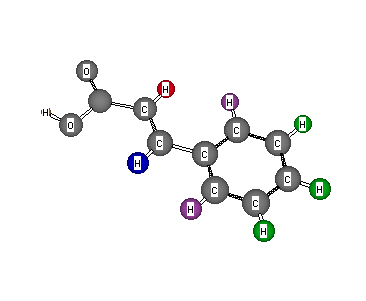Formula: C9H8O2
Answer: Cinnamic Acid
Chemical Shift Assignments: δ 6.40 (1H, d, J = 15 Hz), 7.33 (3H, brd. multiplet), 7.47 (2H, brd. multiplet), 7.67 (1H, d, J = 15 Hz), and 10.94 (1H, broad s)
The degree of unsaturation is 6. The broad singlet at δ 10.94 is a good sign of a carboxylic acid. The group, -CO2H, accounts for one degree of unsaturation and leaves -C8H7 and 5 degrees of unsaturation. The two 1H doublets at δ 6.40 and δ 7.67 coupled by J = 15 Hz indicates a double bond with trans-hydrogens. This leaves -C6H5, which is a phenyl ring. The aromatic hydrogens at the meta and para positions are indistinguishable. In α,β-unsaturated carbonyl compounds bearing α- and/or β-hydrogens, the β-hydrogen is usually more deshielded and at lower field than the α-hydrogen. Think about the resonance structure.
The 13C NMR spectrum is a dilute solution. Note the intense triplet centered at 76.9 ppm due to CDCl3. There are seven singlets downfield from the triplet that account for the nine carbon atoms in cinnamic acid. The ortho and meta carbons are equivalent and are the two most intense signals at 128.4 (ortho) and 128.9 ppm (meta). The weak signal at 133.8 ppm is the ipso carbon (no hydrogens attached) and the para carbon is at 130.6 ppm. Of the three remaining carbons, the carbonyl carbon (weak) is downfield at 172.7 ppm while the vinyl carbons are located at 117.4 ppm (α) and 147.1 ppm (β). The β -carbon is more deshielded than the α-carbon owing to the resonance contribution of the carbonyl group. Return to Menu.
 |
oxygen-yellow
|
|---|